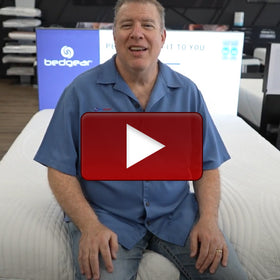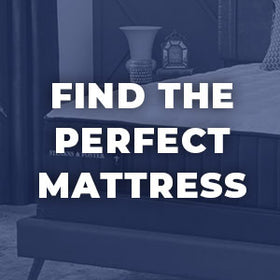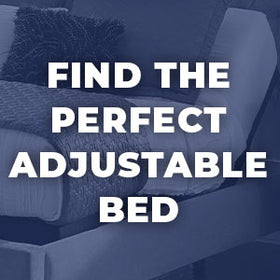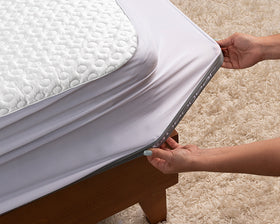888-996-9890

The History of Tempur-Pedic
How One of the Biggest Names in Sleep Got Its Start
Over the years, Tempur-Pedic® has grown to become a name that most people recognize off the bat. Many remember the “famous wine glass test,” where a glass of red wine is tested as someone moves on the other side of the original TEMPUR® mattress. It was a great way to show off how Tempur-Pedic mattresses were better at offering motion cancellation than a traditional innerspring mattress.
But where did it all start? How did the company become the leader in sleep science that it is today?
From Space to Sleep
Tempur was originally based on NASA's research to develop a material that could cushion aircraft seats and increase survivability in the event of an accident. In 1966, Ames contracted Stencel Aero Engineering Corporation to help develop this safer seating system for commercial aircraft.
This resulted in a viscoelastic foam material. One of the people seen as a co-founder of the material was Ames scientist Chiharu Kubokawa, who performed the early experiments with the material. He stated, "I was trying to develop seating for aerospace vehicles[,] so people could better survive any crashes or impacts. We crash-tested several seats at the Civil Aeromedical Institute in Oklahoma City[...], and we found the foam was good for 36 g's. The seat can out-survive the aircraft in a crash."
That is some impressive material.
Another co-founder was Charles A. Yost, who perfected the foam and pursued its commercial potential in conjunction with NASA from Dynamic Systems Inc., his North Carolina-based company started in 1969. He was the one who named the material Temper Foam because of its temperature-sensitive nature.
The foam is made up of billions of high-density viscoelastic cells ("visco" referring to the resistance to a change of shape and "elastic" referring to its ability to return to its original shape). These "memory" cells as they became known get softer and pliable when warm and stay firm when cool. This feature made Temper Foam the perfect cushioning material because it could conform to the body’s contours and offer high energy absorption, which we’d later see as motion-cancellation.
The material could absorb sudden impacts without a huge disruption to the surface or other areas of the material. Plus, it could return to its original shape even after 90% compression. Dynamic Systems applied Temper Foam to ejection seats and crash safety seats in aircraft, then went on to put it in things like wheelchair cushions, X-ray table pads, off-road vehicle seats, ski boots, and even sports equipment including football helmet liners, body padding, and baseball chest protectors and shin guards.
They successfully created a viscoelastic material that they also called a “slow spring back foam.” Decades later, when NASA released their formula to the public, Swedish scientists took this space-age foam and perfected it for sleep. They called it TEMPUR® material.
In 1974, the product line was sold to the Edmont-Wilson division of Becton, Dickinson & Co. They greatly expanded the production of Temper Foam products. Despite its potential, however, Temper Foam was difficult to manufacture at first as it was very much dependent on maintaining proper humidity levels. But this would get a lot better in the next few years.
Tempur-Pedic on the Horizon
In the early 1980s, NASA marked the formula for the viscoelastic material public domain, and a number of companies started working with it to further develop its commercial uses, but most gave up when the material proved to be more temperamental as opposed to just temperature-sensitive. One of the companies who wouldn’t give up so easily ]was a Swedish firm, Fagerdala World Foams. Through a subsidiary, Don Foam A/S, it dedicated a whole ten years to perfecting the material for consumer use, in particular for mattresses.
Fagerdala branded a version of Temper Foam in the early 1990s, naming it TEMPUR, which the company could produce in several different shapes and sizes, as well as densities. In 1991, Fagerdala introduced the Tempur-Pedic Swedish Mattress to the world and enjoyed immediate success in its home market.
Within three years of the product's launch, they sold 50,000 mattresses in Sweden, which had a population of just eight million. Also in the early 1990s, Fagerdala gave the North American distribution rights to Robert Trussell, a man from Lexington, Kentucky who along with a co-founder went on to create Tempur-Pedic, Inc.
When he originally founded Tempur-Pedic, Inc. Trussell had no background in foams or mattresses. Being from Kentucky he started off being involved in the breeding of thoroughbred stallions for racing and the business of packaging partnerships to race the horses in England and France. His racing connections were actually what drew his attention to TEMPUR, and it was the perfect time as he was in the market for new ventures. One of his good friends,a French horse trainer who knew a Swedish horse chiropractor, who in turn knew a fellow Swede who was involved in both horse racing and the mattress business, turned him onto the material.
Then in 1991, he met with a Fagerdala executive and was the given the opportunity to sleep overnight on one of the new mattresses. He was immediately impressed and new this type of bed had huge potential. When he was give the chance to get the distribution rights to the foam mattresses as well as bed pillows and wheelchair cushions, Trussell went back home to Kentucky and partnered with a grade-school friend, Bob Hoeller, to write up a marketing plan. After a short time, they then sent it off to Stockholm for approval.
In January 1992 a Fagerdala VP, Mikael Magnusson, flew to America to meet with them and they were subsequently granted the North American distribution rights to the Tempur-Pedic product line. Tempur-Pedic was almost up and running, but first they needed to obtain the necessary funding to launch the business. Trussell raised about $500,000, turning to family and friends, in several cases people who had invested with him before in his racing ventures. In a 1994 profile in the Lane Report, Trussell remembered the challenge of going up to some of those earlier investors. He said, "I had to convince them that although we lost money on something I know a lot about, which is horses, we [would] make money on something I know nothing about, which is mattresses."
Then in 1992, Trussell and Hoeller raised enough money to start the business and Tempur-Pedic Inc. was born. The Swedes from Fagerdala also purchased a stake in the company, using cash as well as stock, and Tempur-Pedic soon started to see strong growth, appealing in a big way to chiropractors and physical therapists. A retail outlet at a Lexington Mall, the Tempur-Pedic Swedish Mattress Centre, also opened and aided in driving sales.
By 1995 the company was generating $6.5 million a year inl sales. Trussell wanted to expand Tempur-Pedic into ten regional medical markets as well and wanted to do so in six months, but all he had at his disposal was a single sales manager and a handful of independent sales representatives.
He needed to expand his staff first. Through Sales Staffers International, a Danvers, Massachusetts company, he created a transitional outsourced national sales team. After interviews, a 60-day trial period, and another 90 days of watching the reps on the job, Tempur-Pedic paid Sales Staffers to fully employ the most productive reps. With this expanded sales force of dedicated professionals, by the end of 1995 Tempur-Pedic was a $14 million company.
Forming Tempur-Medical
In addition to mattresses, Tempur-Pedic also sells bed pillows, back support pillows, office chairs, recliners, and even bicycle seat covers, padded shoulder straps, and pet beds.
In 1996, Tempur-Pedic created a separate subsidiary for its medical business, Tempur-Medical Inc. Since the material conforms to the body, it proved to be useful in preventing bed sores on bed-bound individuals. Attempting to sell to nursing homes and hospitals one at a time, however, was a challenge and many competitors seemed to have a leg up because they sold cheaper units in bulk.
So, Tempur-Medical fine-tuned its approach, focusing on the problem of bedsores, an increasing subject of litigation, and over the next few years the Tempur-Medical Ultimate Skin Management Program was created and took off because instead of just selling mattresses to a nursing home, they offered a comprehensive program, charging on a per-year resident basis. In addition to supplies, the program offered insurance, covering the first $250,000 of a judgment or settlement over bedsore litigation.
Tempur-Medical also targeted Florida and other states that were seeing a high level of bedsore suits. As Tempur-Medical was able to demonstrate that it could lower the incidence of bedsores to 1% or less, its mattresses and prevention program became very popular and did well.
Everything Tempur
In 1999, Tempur-Pedic, Fagerdala's Dan Foam subsidiary, and eight other distributors around the world merged together to become Tempur World. Trussell was named CEO of Tempur World, mostly run out of the Kentucky offices of Tempur-Pedic, which he continued to head. Best of all, Tempur-Pedic continued to grow revenues at a steady clip.
The company also added several new products, including office chairs and recliners that used the foam in their padding. As a treat for that time and to aid in marketing, Tempur-Pedic created a "Space Cabin" for consumers to experience at furniture shows. Customers could lay on a Tempur-Pedic mattress in a dark room and watch a ten-minute simulated space flight. The space cabin called back to the materials beginnings, and when it was then used by retailers, more and more customers purchased one of their revolutionary mattresses.
The good word about Tempur-Pedic was spreading and more and more people were seeing the benefits that the innovative TEMPUR Foam had to offer. The company enjoyed several successful television direct sales, and in 2002 the mattresses were even used as a free gift certificate in the goodie basket given to the presenters at the Academy Awards.
After ten years in business, the company saw an average yearly sales increases of 49%, reaching the $150 million range in 2002. Later, the company went public in 2003. But what would certainly become the biggest move cam in 2012 when Tempur-Pedic and Sealy Corporation announced plans to merge to form "the world's largest bedding company." This brought the two largest brands in the mattress world together and made it even easier to make sure that customers were always getting the bed they needed.
Tempur-Pedic has gone on to see great success. They won a 2009 Electronic Retailing Association (ERA) award for direct marketing. In 2010, they announced its alliance with Ronald McDonald House Charities and began outfitting four U.S. Ronald McDonald Houses with beds in 2009. Recently, Tempur-Pedic is a three time JD Power & Associates award winner as #1 in Customer Satisfaction, was voted Best Mattress of 2020 for the TEMPUR-LUXEbreeze° by Popular Mechanics® Home Awards, and the material has even been inducted into the the Space Technology Hall of Fame.
Tempur-Pedic’s Mission
At Tempur-Pedic, they “don’t just make mattresses.” As a company, they value the sleep of each of their customers. The way you sleep, your lack of sleep, and the future of your sleep have a direct impact on the way they design and evolve the Tempur-Pedic experience, including branching out into the world of Smart Sleep with the Tempur-Pedic Ergo Extend Smart Base with Sleeptracker-AI.
They make their decisions based on research, rigorous testing, expertise, and invention. As a whole, they are committed to precision and ensuring every detail in their products improves the sleep of people everywhere. Their sleep scientists, engineers, and technicians work together to ensure each mattress that is made offers the absolute best.
Their mission is “to bring you better sleep than the night before.” With more than 2.6 million hours of research, testing, development, and innovation, they pride themselves on one simply truth- they deliver deep, restful, and life-changing sleep.
When you purchase a Tempur-Pedic from us, the warranty covers the mattress for 10 years, which is as long as traditional mattresses are typically expected to last. Plus, you can know that you’re buying a mattress backed by The Arthritis Foundation, which makes the company a strong choice for those with joint pain.
Tempur-Pedic for the Ages
Tempur-Pedic will always be remembered as one of the pioneers of the luxury mattress industry. Because of their history, some of their people also associate the brand with NASA, and for good reason. The TEMPUR material was created for NASA. Tempur-Pedic delivers a mattress that combines comfortable materials and cooling technologies to create an incredible sleeping surface.
Throughout the years, they’ve continued to innovate and improve on this original formula, particularly when it came to studies showed that a cooler sleep environment makes falling happen quicker and helps you to stay asleep longer. In fact, they’ve approached climate research innovation the same way experts approach space exploration by using the scientific method and experimentation.
That’s why their latest innovation, the TEMPUR-breeze°, is their most-awarded and best-rated mattress collection yet. With premium cooling technologies that allow heat and humidity to be cycled out of the mattress, you’re able to sleep more deeply and wake up feeling refreshed. These types of innovations and developments are something you can count on from Tempur-Pedic for years to come.
If you have any questions we’d be glad to help. You can reach out over the phone or through email at info@bedplanet.com. We know that sleep is important to you, and it's crucial to us. Allow us to help you find the perfect mattress for your needs so that each and every night is the best night of sleep.





